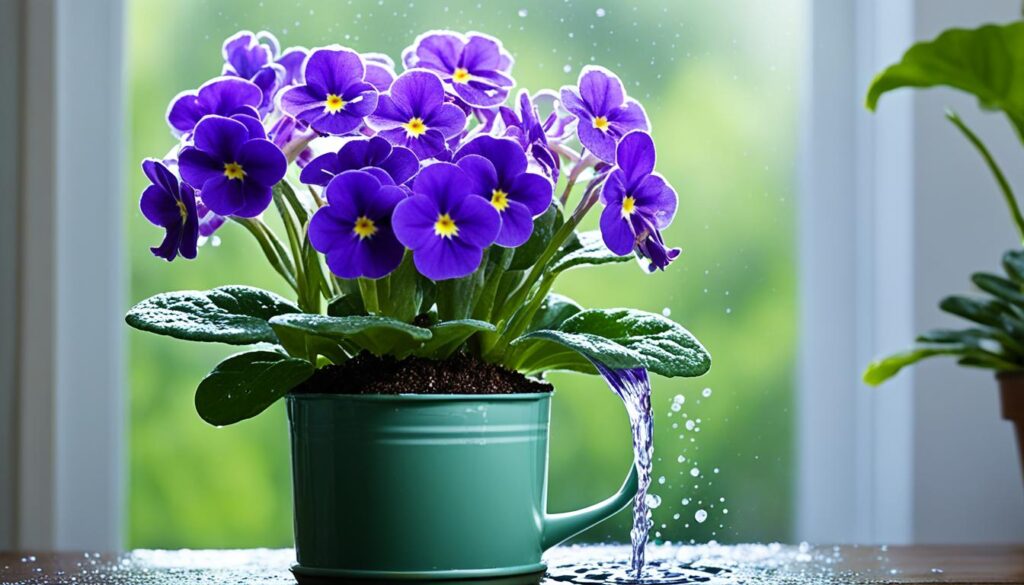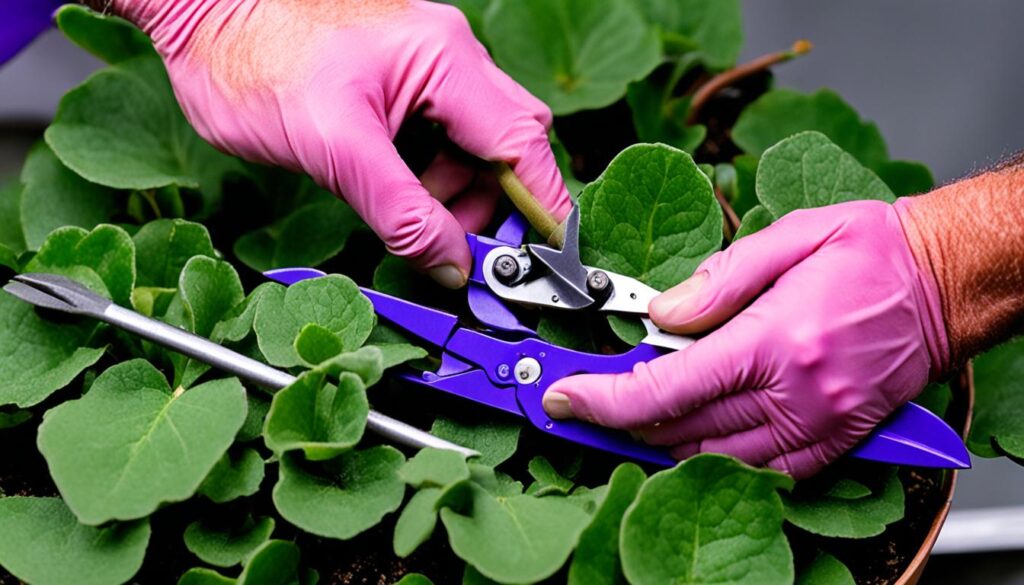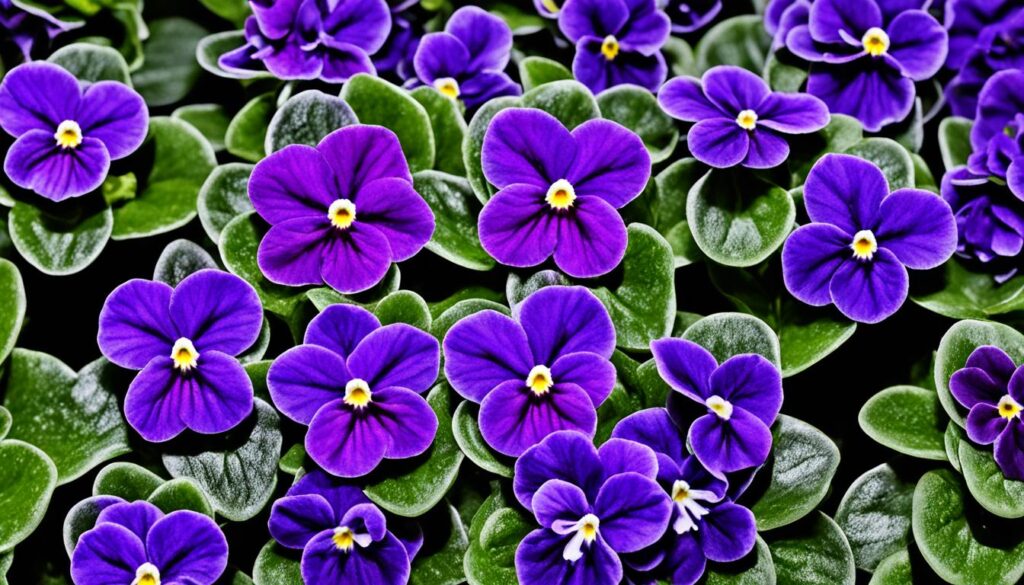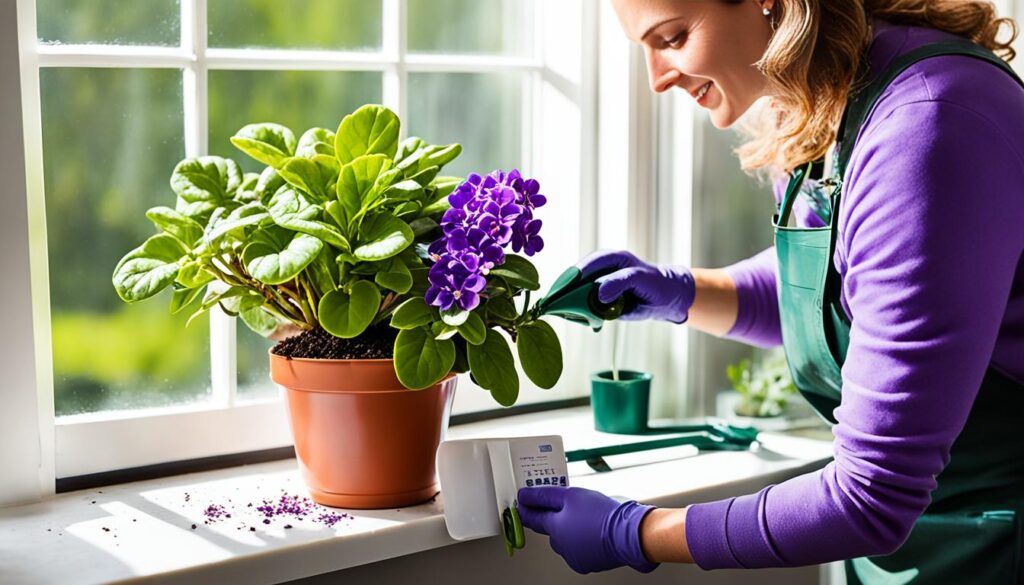African violets are a favorite houseplant worldwide. They’re loved for their colorful flowers and neat size. These tropical plants come from East Africa’s rainforests. With the right care, they’re easy to grow. This detailed guide covers everything you need to know about African violet care. Topics include buying and repotting, soil and fertilizer, watering, lighting, and more. By using these tips, you can enjoy beautiful, healthy African violets at home.
Key Takeaways
- African violets are a popular and beloved houseplant known for their vibrant blooms and manageable size.
- Proper growing conditions, including lighting, temperature, humidity, and soil, are crucial for the health and blooming of African violets.
- Repotting, pruning, and propagation techniques are essential for maintaining and expanding your African violet collection.
- Understanding and addressing common pest and disease issues can help keep your African violets thriving.
- With the right care, African violets can bloom continuously for months and live for up to 50 years.
Introduction to African Violets
African violets are loved for their small size, perfect for indoor spaces. Their African violet basics draw people in. The plants grow into neat rosettes that are 4 to 6 inches tall. They are 3 to 16 inches wide. The leaves are thick and fuzzy. They range in color from dark green to bronze. Some have silver, white, rose, or purple undersides.
Reasons to Love African Violets
The flowers look like violets and have five petals. They come in many colors like white, pink, and deep purple. With proper care, they can bloom all year. This makes them a rewarding and easy-to-grow houseplant.
Compact and Manageable Size
These African violet features are great for small spaces. You can grow them on windowsills or tables. Their small size makes them perfect for apartments and small homes.
Beautiful Blooms in Various Colors
African violets come in many colors. You can find purples, blues, and even pink. This variety lets gardeners create vibrant collections. There’s a color for every style.
Easy to Grow with Proper Care
With the right why grow African violets knowledge, they’re easy to care for. They are perfect for new gardeners. Simply follow some care tips to keep them blooming all year.
Buying and Repotting African Violets
When picking out new African violets, find those with firm leaves and lots of flower buds. Don’t choose ones that are wilted, yellow, or have bad leaves. For the best growth, repot them right when you get them. The pots they come in at the store aren’t great for their long-term health. Repot them using a special mix in a container about one-third the size of their leaf spread. This helps them be slightly rootbound, which makes them bloom more.
Selecting Healthy Plants
Choose African violets with bright, healthy leaves and many flower buds. Avoid those that are wilted, yellow, or look unhealthy. Picking strong, healthy plants is key to successfully growing African violets. They will also look better in your home.
Repotting Right Away
As soon as you bring African violets home, repot them. The plastic pots they come in are not good for them long-term. Use a fresh mix made for African violets. This gives them the ideal start for healthy growth.
Pot Size and Requirements
Find a new pot that’s about one-third the size of the plant’s leaves. This will help them thrive by being slightly rootbound. Avoid covering the plant’s crown when you repot it. Remember, it’s good to repot them with fresh soil once a year.

Soil and Fertilizer for African Violets
African violets do best in a potting mix that drains well. Look for a African violet potting mix at the store. It usually has sphagnum peat moss, vermiculite, and perlite. These materials keep the soil moist, drain well, and let air move around the roots. You can also mix your own homemade African violet soil with peat moss, vermiculite, and perlite.
Choosing the Right Potting Mix
The ideal African violet potting mix balances moisture and air for these plants. They like soil that’s not too compact and lets roots grow well. A mix with perlite helps air move, which is good for the roots.
Making Your Own Potting Mix
It’s easy and cheap to make your own homemade African violet soil. Just mix peat moss, vermiculite, and perlite in equal parts. This mix keeps just the right amount of water, drains well, and holds nutrients for the plants.
Fertilizing African Violets
Feed your African violets a balanced African violet-specific fertilizer from spring to fall. Water the plant as the fertilizer’s instructions say. For the best results, use a mild, plant-specific fertilizer weekly. A fertilizer with the mix 20-20-20, or one slightly higher in phosphorus, works well.
Don’t use too much fertilizer, though. A good choice is the mix 14-12-14 for African violets. This mix is good for nitrogen, phosphorus, and potassium. Strong fertilizers with urea can hurt the roots. If your plant isn’t flowering, try a higher phosphorus fertilizer.
Watering African Violets
Good watering habits are key to keeping African violets healthy and flowering. Let the top inch of soil dry between each watering. Use only room-temperature water for each session. One smart way to water is bottom watering.
Put the plant’s pot in a shallow container with water for an hour. This lets the soil soak up water from below. Remember, never wet the leaves to prevent damage and sickness.
Too much water for African violets is bad news. It can cause their roots to rot and harm the plant. Change the watering routine according to your home’s humidity and the plant’s age. A wet feel to the soil means you’re overdoing it.
African violets like their soil moist but not waterlogged. Keep an eye on how damp the soil is to avoid issues. With a bit of care, your African violets will thrive.

Light Requirements for african violet care
African violets love bright, indirect light by east- or north-facing windows. They need 50-75% sunlight exposure for their flowers and leaves to stay healthy. It’s important to keep them away from direct afternoon sun to avoid leaf damage.
Rotating Plants for Uniform Growth
Rotating your African violets ensures they grow evenly. Turning them a quarter each week prevents them from growing lopsided. This also helps keep their leaves and flowers nice and even.
Using Grow Lights in Winter
In winter, grow lights can be a great supplement for your violets. Place the plants 6 to 12 inches under the light and keep it on for 12 to 14 hours a day. This ensures your violets keep their vibrant blooms throughout winter.
Temperature and Humidity Needs
African violets love warm, humid places like their tropical homes. They thrive in 60 to 65°F at night and 70 to 80°F during the day. Keep them away from cold drafts and AC vents to prevent damage.
Increasing humidity is easy. Place the pots on a tray of pebbles and water but make sure the roots don’t touch the water. Using a humidifier or a nearby bowl of water also helps. Giving them the right temperature and humidity is key for their health and flowers.
Using Pebble Trays for Humidity
Using pebble trays is a great way to boost humidity for African Violets. The pot sits on a tray with water and pebbles, creating a humid space. Be careful not to let the roots sit in the water to avoid root rot.
Pruning and Leaf Care for African Violets
Caring for your African violets means regular pruning and leaf care. Remove old flowers and damaged stems to push for new blooms. Dusty leaves need gentle cleaning with a soft brush. Always remember, avoid touching the leaves directly, especially if your hands have lotion. This can harm the plant’s growth. Also, keep water off the leaves to prevent spots. Good pruning and leaf care is key for healthy African violets.
Removing Spent Flowers and Dying Stems
Keeping African violets beautiful means cutting off old flowers and stems. This care, including pruning African violets, tells the plant to bloom more. Just pinch or cut away the old parts to help your violets thrive.
Cleaning Leaves with Soft Brush
African violets’ leaves can get dusty. To clean them, softly brush them. Remember, be gentle and never touch the leaves directly – it can be harmful.
Avoiding Direct Contact with Leaves
Always be careful not to touch your African violet’s leaves directly. Avoid contact when you water or prune. This simple step can prevent growth problems in the long run.

Propagation and Repotting
Did you know you can make more African violets from leaf cuttings? All you have to do is take a healthy leaf and let its cut end heal. Then, plant it in a good soil mix. This method lets you grow new plants without spending money. If your African violet has many crowns, you can split them when you change their pots. This gives you even more plants.
Propagating from Leaf Cuttings
To start, pick a big, healthy leaf and remove it safely. Let its cut end dry to protect it, and then plant it in special soil. This soil must let water drain well. Keep the soil a little wet, and soon you’ll see baby plants growing from the leaf’s base.
Dividing Multiple Crowns
If your African violet has more than one crown, you can divide it to get more plants. First, take the plant out of its pot. Then, gently separate the crowns with your hands. Make sure each part has good roots. Plant these parts in their own pots without covering the crowns too much.
Repotting Signs and Techniques
Know it’s time to repot your African violet when it looks cramped, or the roots are showing. When you move it to a new pot, pick one that’s a bit bigger. Make sure not to cover the crown with too much soil. Doing it right helps your African violets grow well for a long time.
Pest and Disease Control
African violets can face many enemies, such as pests and diseases. But with the right steps, we can tackle these problems well. Crown & Root Rot is a serious fungal issue for these flowers. It comes from fungi like Pythium and Phytophthora species. Botrytis blight, caused by the fungus Botrytis cinerea, is also common. To keep your African violets safe, it’s vital to water them correctly. Use soil that drains well and is airy.
Preventing Root and Crown Rot
Too much water and bad drainage cause root and crown rot. To prevent this, let the soil dry out a bit between waterings. Use a special mix for African violets. Ingredients like peat moss, vermiculite, and perlite help with air and water.
Dealing with Powdery Mildew
Powdery mildew is common on African violets. If you see it, treat it fast with a special fungicide to stop the spread. Keeping the air around your plants moving and at the right moisture level can also stop powdery mildew.
Managing Common Pests
Many pests, like cyclamen mites and mealybugs, can harm African violets. Cyclamen mites and different mealybug types are big trouble. Act quickly with the right insecticides if you find pests. This protects your plants from more harm.
Good growing conditions and knowing how to spot pests and diseases are key. With the right care, your African violets will stay beautiful for a long time.

Popular African Violet Varieties
There are lots of African violet types out there, offering a vast range of colors, shapes, and leaf patterns. You can find single-bloom kinds with five petals or double-bloom types with more than ten petals. This makes the African violet bloom varieties truly amazing.
African violet foliage varieties bring a burst of colors and designs. They come in lush greens, striking bronzes, and they may have silver, white, rose, or purple undersides. Some even have fancy, variegated leaves that really catch the eye.
If you love different petal shapes, African violets have a lot to offer. There are ruffled, frilled, and fluted kinds. This means there’s a violet out there for everyone’s unique tastes and gardening styles.

With countless unique African violet cultivars to explore, there’s a violet for every preference. You might like solid-colored blooms, eye-catching bicolor patterns, or the lively looks of bronze and variegated types. The variety in the African violet world makes it possible for all growers to have a beautiful, varied collection.
Conclusion
African violets are loved for their compact size and beautiful blooms. By using this guide, you can easily grow and keep them healthy. We’ve covered all you need to know about caring for African violets, from picking the right potting mix to managing light and humidity.
With the right steps, like propagation, pruning, and handling pests, your plants will flower beautifully for many years. This guide is for everyone, whether you’re new or experienced with these plants. It has what you need to make your collection stand out.
To keep your African violets in top shape, remember these key points for success. This means the right temperature and humidity, plenty of light that’s not too direct, and caring for them properly. Following these tips will help you have happy, flourishing plants that brighten your home.


